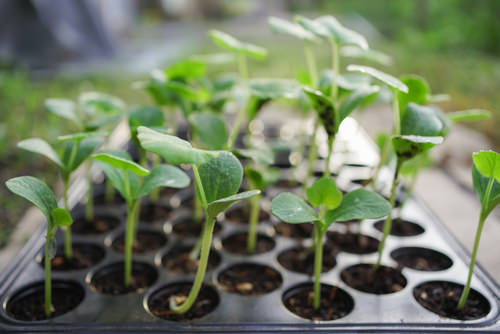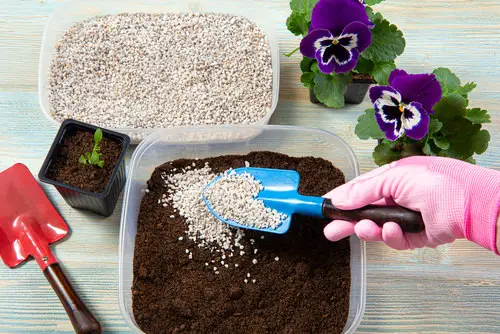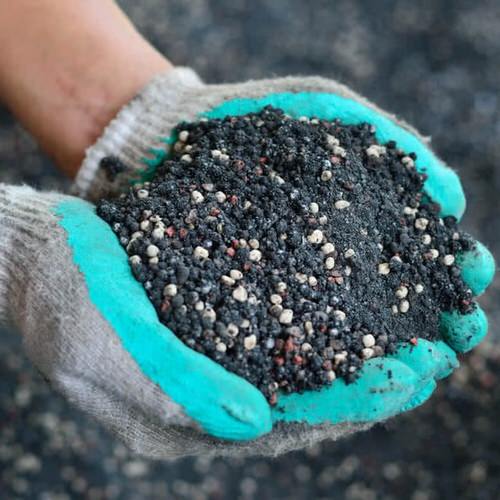Why splurge money when you can make your own seed mix easily? Check out these Best Homemade Seed Starting Mix Recipes below.

We have some amazing Homemade Seed Starting Mix Recipes for you that can be made at home easily!
Here are the common Seed Starting mistakes you need to avoid
Seed Starting Mix Recipes
1. Peat Moss or Coco Peat

Peat Moss
Peat improves aeration and can save a lot of water. It is acidic and contains less or no nutrients, and if you’re using peat, *add 1/4 tablespoon lime per gallon in the mix to balance the pH.
The biggest downside of using peat is that it can only be obtained by destroying the remaining mires. There are other peat-free alternatives like coco peat you can opt for.
You can also start seeds in pure peat moss, without mixing it with any other growing medium.
Coco Peat
The best alternative to peat moss is coco peat. Coconut fibers are offered in lightweight blocks that swell to become large when water is added. The Benefit of using coco peat over peat moss is that its production doesn’t harm the environment.
It also has macro-nutrients and traces of potassium, and it is neutral, unlike peat, which is acidic.
You can start seeds of tomatoes and peppers in pure coco peat. It acts as a natural anti-fungal, which helps to keep the potential issues at bay.
Both 100% peat moss and coco peat become great growing mediums for propagating succulents.
Alternatives
- Leaf Mold: Leaf mold is a kind of a lazy man’s compost. It is an outcome of the natural rotting process of leaves. You can use leaf mold to sow seeds. Here’s an interesting post on The Guardian for you to read.
- Pine Bark Humus: Bark humus is produced from the composting of the bark. The bark originates mostly from conifers. These crusts must be composted for a long period of time. The result is perfect for growing plants: Water permeable and stable structure. The small roots can grow unhindered.
- Composted Wood fiber: Wood fibers have similar favorable properties as coir. They are also low in nutrients. The material must, of course, should not come from treated wood waste.
- Cat Litter: Cat litter is a good ingredient for plants that requires very few nutrients. For example, cacti. You can give seedlings the best ground for rooting with a nutrient-free mixture of perlite or pumice and cat litter.
Important: Use non-clumping, mineral-based cat litter.
2. Perlite or Vermiculite

Perlite
Perlite is a volcanic mineral. It doesn’t absorb water or other nutrients, thus improving drainage. It also has insulating properties that help the plant roots during fluctuation in temperature. You can also use pumice instead of perlite.
Vermiculite
Vermiculite is light, but unlike perlite, it retains water and nutrients and releases that when needed. It also helps in drainage.
Alternatives
- Sand: You can use sand if you don’t have perlite or vermiculite. Sand is always there as a part of the soil. It is important for a stable soil structure and drainage. Sand does not contain any nutrients.
3. Compost

Compost is used in a few seed starting mix recipes. If you’re using compost make sure it is fine. You can also use manure instead of it.
Homemade Seed Starting Mix Recipes

Make seed starting mix depending on the seeds you’re sowing and their nutrient requirements. We have divided these recipes into three types: Recipe 1, for high energy requirements seeds. Recipe 2 and 3, for medium and low energy requirement seeds.
- High requirement seeds are those that require more energy to germinate. Many annual flowers and vegetables, such as potatoes, tomatoes, cabbage, sunflower, and geraniums.
- Average requirement seeds are the ones that need less energy for germination. This includes Allium, pumpkin, cucumber, snapdragons, dahlias, and gloxinias.
- Low requirement seeds are those that require less or no nutrients for germination. They are most of the herbs, lettuce, azaleas, begonias, petunias, and pansies and most of the plants belong to Crassulaceae family and palm species
Basic Seed Starting Mix Recipes
These two basic seed starting mix recipes are the easiest, most popular, and perfect.
- The easiest seed starting mix recipe is to add 1/2 part of perlite, vermiculite, or sand and 1/2 part of peat moss or coco peat.
- Mix 1/3 part coco peat or peat moss, 1/3 part compost, and 1/3 part of vermiculite or perlite or sand.
Recipe 1 (High Requirement)
Peat or Peat alternatives 40%
Compost 30%
Garden soil, sand, and bark humus 30%
Recipe 2 (Average Requirement)
Peat moss, coco peat, or wood fiber 55%
Compost 20%
Sand 15%
Bark humus 10%
Recipe 3 (Low Requirement)
Peat or Peat alternative 50%
Perlite or Perlite alternative 45%
Bark humus 5%
Sterilization
Mix the proportion well before sterilization and make it evenly moist (especially when you are using peat moss). This happens best when the soil is kept in a discarded oven (45 minutes at 150 ° C) or in a microwave oven (10 minutes at 800 watts). This will make your soil disease-free.
Caveat: Dried peat moss is flammable.



If the coconut is endangered and we are loosing the coconut to pandemic lethal yellowing diseases; How is using coconut any better for the ‘environment’ than peat?. This article claims “the biggest downside of using peat is it can only be obtained by destroying the remaining Mires”. OK but what about the destruction of the coconut from yellow diseases? Furthermore, the “production” of coco peat also harms the environment. If you are going to write an article claiming people should not use peat because the only way to get peat is to destroy the remaining mires, you must also state that in order to get coco peat we must destroy the remaining endangered coconut.
http://www.iflscience.com/plants-and-animals/the-end-of-coconut-water-the-worlds-trendiest-nut-is-under-threat-of-species-collapse/
it’s not coco peat, its a part of the husk of the coconut that is used. It has absolutely nothing to do with destroying groves of coconut trees
Right on!! Very well said , Tim!! The trees are unharmed…just need their nuts!!=)
coconut husks are the by product of the coconuts that we discard . It IS a renewable resource.
Creating additional uses for products such as coconut, that are plantable and harvestable, increased investment in the agriculture of said product, and means that people are more likely to want to find solutions for problems associated with the product. Finding additional uses for an agricultural crop is only harmful if lands that would’ve been better left untucked are then modified for cultivation of said crop.
This is why use of paper products isn’t really as bad as many people believe- those trees are a commodity, and they’re *going* to be replaced. The problem is even we grow too many fast growing, profitable trees and other native area trees lose habitat or resources.
thank you for being frank
Frank,
It seems you have not heard of coconut…it is available in plenty in equitorial regions and the outer skin of the nut is used as coco peat…it actually not a peat but some one started calling it peat because of usage….it is not endangered by any streatch….there are more endangered animals and birds than coconuts….
Too Right, Banana!!! Well said!!! It’s al about the nuts!!!=)
Come to India my friends…There are endless coconut groves for miles and miles we go. We get Cocopeat at as cheap as $1 per Kg.
I like we all Coco nuts equally as much as other humans, and all other nuts…
Coco coir is combustible, too. Not just peat. Ask me (and my insurance company) how I know.
Instead of sterilizing your mix in an oven, it is much safer and just as effective to hydrate your mix with boiling water and letting it sit until cooled-off.
Thank you for that alternative!!
I agree with Frank in part. The article is skewed. The argument that coco peat is more environmentally friendly is an argument of emotions. It feels good to save something. Currently they are planting over precious wetlands in the Southern Hemisphere to produce enough Coconut Palms & Palm Oil Palms to satisfy the wants of those thousands of miles away, such as Tropical Peat Forest of Indonesia or Tidal Wetlands in Sri Lanka.
In part of Europe, like the UK there has been significant over production of the peat. Ireland & Finland still burn it for Power. Talk about killing the Mires. Many experts in England are turning towards Composted Pine Bark as an alternative.
In Canada, there are more peat bogs than people. There have only ever been 1-7% harvested. Now a days they are removing the top layer to replant in the area that was harvest last. This also includes growing from tissue culture to replace what cannot be saved. Depending on the species of Spaghnum moss, some can grow quite rapidly. It takes about 10 years for a harvest area to completely recover. The industry does worry about having a negative image, so they have made these moves to give back to what they have taken. Of course they care, it’s money they loose it they have a bad image. Consumer pressure it good.
To say Coco Peat is a ‘Waste Byproduct’ was & still is used as Coco Peat Marketing. It did not become a waste by-product, until the Western world started to demand coconut be in everything. Prior to the demand for Coco Peat, farmers would reapply it to their fields. Now, they demand synthetic fertilizers, which we know both destroys the biodiversity of the soil as well as disturb wetlands with algae bloom.
Journalist, like those that wrote this article owe it to their readers to do research on a topic before they make decisions on what is best. I am just an average man that one day, asked myself, “Is Coco Peat actually better for me, living in Canada?” My conclusion is we should focus on what we can produce closest to home. On the Westcoast we have fields of planted Douglas Fir, as well as lots of bogs. So, I have added ground bark to my peat moss soil recipe, as well as Beneficial Microbes. I currently in talks with a friend that owns land in the local rain forest. I want to added native microbes, instead wasting energy buying those raised in laboratories. This comes from a guy, who loves to walk in/by peat bogs to see interesting lifeforms. We own some bog plants at home, including the native Purple Pitcher Plant. It’s the floral emblem of Newfoundland & Labrador. The flower is beautiful and very unique. Newfoundland is one of the biggest producers of peat for Canada and the United States.
Thank you for taking the time to read my comment.
I never read your comments. It’s too long so I skipped over it .
You don’t seem to get it. They are not growing coconuts to make coconut coir. If nobody used coconut coir again, they still would grow coconuts for coconut water, coconut meat, etc. Therefore using coir in home gardening is probably better than having it decay in a landfill.
In regards to peet moss. 1) You have to add lime to it to balance the PH. Lime is another product that needs to be produced and processed. 2) To harvest the peet they disrupt and displace the current environment. Of course they use big mechanical machines for that.
This tl;dr idea is pathetic. Let’s change it to ip;cbb (I’m pathetic; couldn’t be bothered). If your reading speed and comprehension is so weak and slow you couldn’t handle that you need to read more. You’re probably functionally illiterate if that’s beyond your level of understanding unless you’re in 7th grade or below. Cullen may have been writing at a 9th grade level but it seems you should be able to read and understand it.
Sweetie, go get a job or do something with your life. You’re clearly bored and mentally unwell. Get outside, make some real life friends, get some professional help. Just touch some grass hun and everything will be ok.
Omg u r not reading to understand u r reading to bitch! Cullen spoke clearly he gets it you don’t ! We are all so caught up in the crap you can’t see the forest for the trees. Today Everything is becoming man made fake … Eat purslane instead of canned corn from China! Purslane for those that don’t understand is a weed very high in omega 3… NO Chemecals!!! Today most don’t understand how bad it is getting!!! The kids today think potato chips are healthy! SAD I am 80 yrs. old and I grow what I eat and I am healthy no Medicines of any kind!! WAKE UP read the labels if you can not pronounce it don’t eat it! Dede
It’s not very long really, good information.